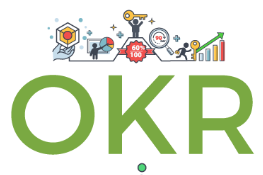OKR (Objectives and Key Results) and Sprint are two different frameworks commonly used in the context of goal setting and project management. Here are 25 differences between OKR and Sprint:
- Purpose:
- OKR: OKR focuses on setting and tracking ambitious objectives and measurable key results to drive alignment and progress towards strategic goals.
- Sprint: Sprint is a time-boxed period (usually 1-4 weeks) during which a team works on a set of prioritized tasks to achieve a specific goal or deliverable.
- Goal vs. Execution:
- OKR: OKR is primarily focused on setting goals and measuring outcomes.
- Sprint: Sprint is focused on executing and delivering specific tasks within a defined timeframe.
- Timeframe:
- OKR: OKRs are typically set and reviewed on a quarterly basis, but they can have longer time horizons (e.g., yearly OKRs).
- Sprint: Sprints have fixed durations, usually ranging from 1 to 4 weeks, and are followed by a review and planning for the next sprint.
- Scope:
- OKR: OKRs can be set at various levels, including company-wide, team-specific, or individual levels.
- Sprint: Sprints focus on a specific set of tasks or backlog items to be completed within the sprint duration.
- Flexibility:
- OKR: OKRs allow for more flexibility in terms of adapting goals and priorities as the business landscape evolves.
- Sprint: Sprints have a fixed duration and scope, aiming to provide a stable environment for focused work.
- Alignment:
- OKR: OKRs ensure alignment and cascading of goals from high-level company objectives to team and individual goals.
- Sprint: Sprints focus on team-level alignment and coordination for executing tasks and achieving specific goals.
- Tracking Progress:
- OKR: OKRs are tracked based on key results, providing measurable indicators of progress.
- Sprint: Sprint progress is tracked through daily stand-ups and visual management tools like Kanban boards or Scrum boards.
- Emphasis:
- OKR: OKR emphasizes outcomes, impact, and results.
- Sprint: Sprint emphasizes task completion and deliverables within the set timeframe.
- Adaptability:
- OKR: OKRs encourage flexibility and adaptability, allowing for adjustments and course corrections throughout the set timeframe.
- Sprint: Sprints prioritize stability and aim to minimize changes during the sprint duration.
- Continuous Improvement:
- OKR: OKRs foster a culture of continuous improvement by encouraging reflection, learning, and iterative goal setting.
- Sprint: Sprints promote continuous improvement through regular retrospectives, where teams reflect on their processes and identify areas for improvement.
- Stakeholder Involvement:
- OKR: OKRs involve stakeholders at different levels to align on objectives and outcomes.
- Sprint: Sprints involve the team and relevant stakeholders in the sprint planning and review meetings.
- Strategic Alignment:
- OKR: OKRs align goals with the organization’s broader strategic objectives.
- Sprint: Sprints align with specific project or product goals, contributing to the overall strategic alignment.
- Measurement:
- OKR: OKRs use measurable key results to track progress and success.
- Sprint: Sprints measure progress based on completed tasks and deliverables.
- Ownership:
- OKR: Ownership of OKRs lies at different levels, with individuals, teams, and leaders owning specific objectives.
- Sprint: Sprint ownership lies with the team responsible for executing the tasks within the sprint.
- Prioritization:
- OKR: OKRs help prioritize efforts and focus on the most impactful goals.
- Sprint:Sprints prioritize tasks based on their importance and urgency within the defined sprint timeframe.
- Planning Horizon:
- OKR: OKRs can have longer planning horizons, such as quarterly or yearly cycles.
- Sprint: Sprints have shorter planning horizons, typically ranging from 1 to 4 weeks.
- Goal Setting Approach:
- OKR: OKR encourages setting ambitious and aspirational goals.
- Sprint: Sprint focuses on breaking down larger goals into smaller, actionable tasks.
- Collaboration:
- OKR: OKRs promote collaboration and cross-functional alignment, as different teams and individuals work towards common objectives.
- Sprint: Sprints encourage close collaboration within the team responsible for executing the sprint tasks.
- Review and Evaluation:
- OKR: OKRs are periodically reviewed and evaluated for progress, alignment, and success.
- Sprint: Sprints are reviewed at the end of each sprint to assess completed work, identify lessons learned, and plan for the next sprint.
- Transparency:
- OKR: OKRs foster transparency by making objectives and key results visible and accessible to relevant stakeholders.
- Sprint: Sprints promote transparency through daily stand-ups and visual boards that display the progress of tasks.
- Framework Applicability:
- OKR: OKRs can be applied at various organizational levels, including strategic, tactical, and operational levels.
- Sprint: Sprints are mainly applicable to project management and agile software development methodologies like Scrum.
- Performance Management:
- OKR: OKRs are often tied to performance management and used to evaluate individual and team performance.
- Sprint: Sprints contribute to performance management by assessing the team’s ability to deliver within the defined timeframe.
- Emphasis on Learning:
- OKR: OKRs encourage a learning mindset by focusing on outcomes, reflection, and continuous improvement.
- Sprint: Sprints emphasize learning through retrospectives, where teams reflect on their work and identify opportunities for improvement.
- Communication:
- OKR: OKRs facilitate communication and alignment across different teams and organizational levels.
- Sprint: Sprints facilitate communication within the team and with relevant stakeholders to coordinate work and track progress.
- Integration with Other Frameworks:
- OKR: OKRs can be integrated with other frameworks like Agile, Lean, or Scrum to provide a holistic approach to goal setting and execution.
- Sprint: Sprints are a core component of the Scrum framework and can be used in conjunction with other project management methodologies.
These differences highlight that OKR and Sprint serve distinct purposes within goal setting and project management. While OKR focuses on setting and tracking objectives and key results to drive alignment and progress towards strategic goals, Sprint is a time-boxed period for task execution and achieving specific deliverables within a defined timeframe.

Leave a Reply